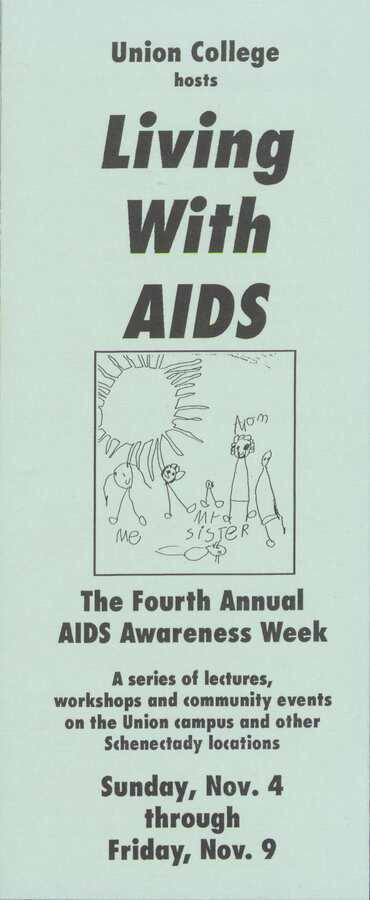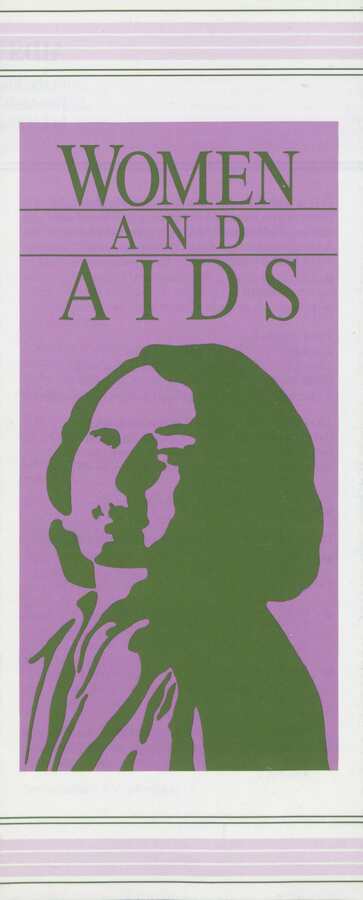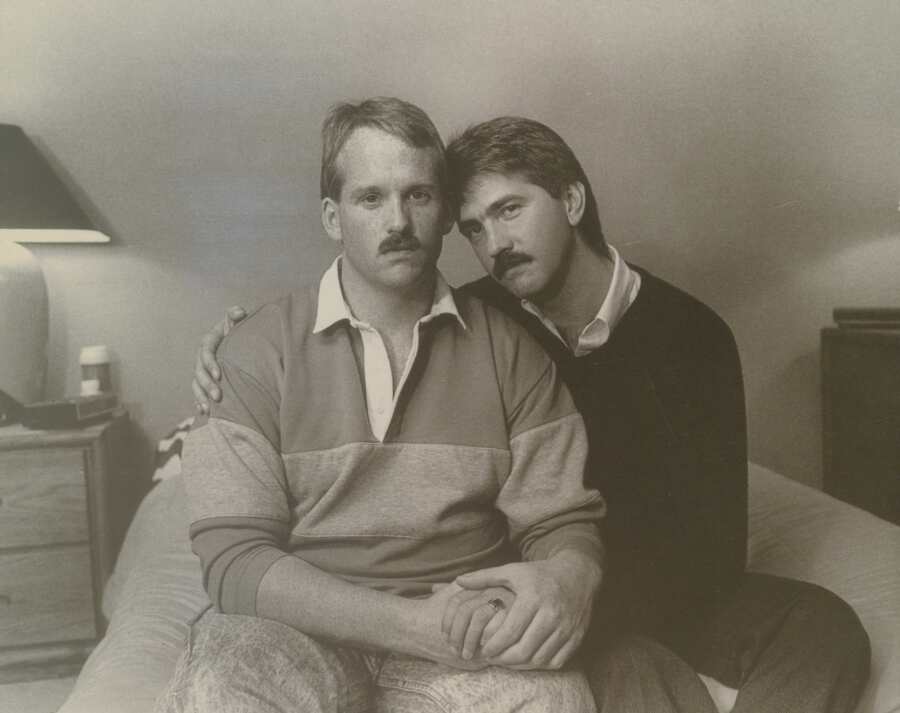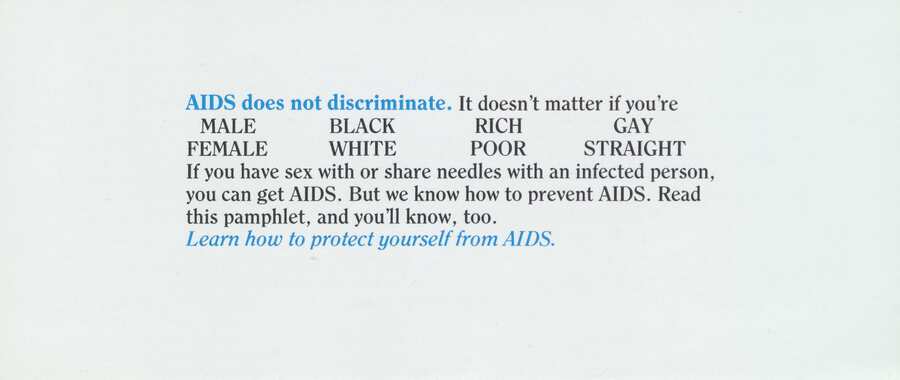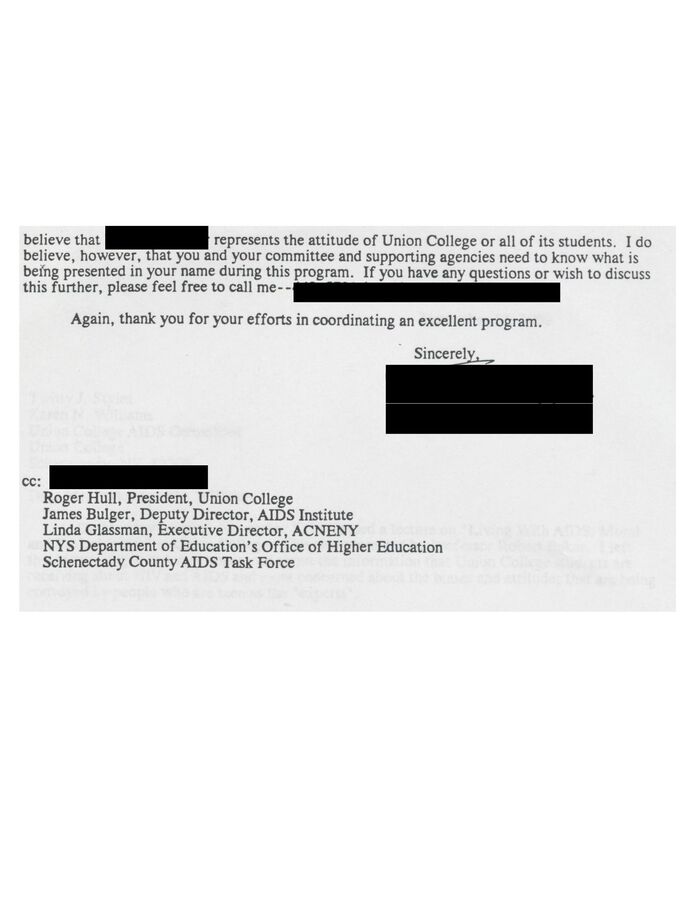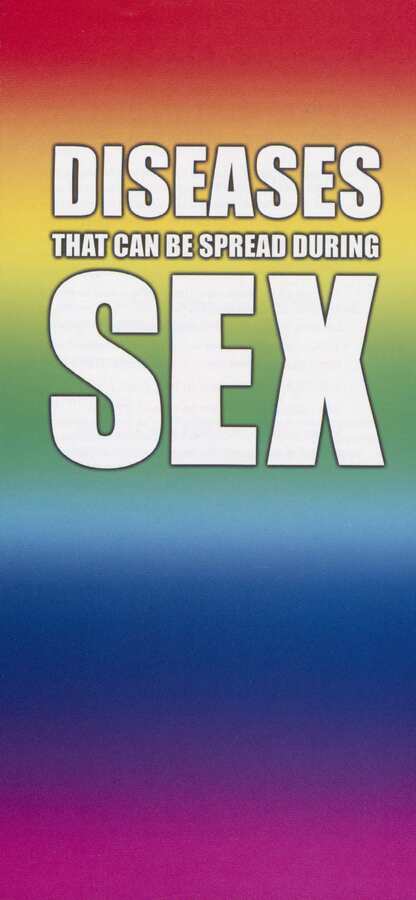"Disease of the AIDies"
The Union College AIDS Committee, 1986-1994
HIV and AIDS related research and education was spearheaded at Union College primarily by faculty in the Biology Department from a public health lens.
The Union College AIDS Committee was formed in 1986 and co-chaired by Professors Twitty J. Styles and Karen N. Williams of the Biology Department.
For eight consecutive years, the AIDS Committee held an "AIDS Awareness Week," which engaged both the Union community and members of the broader Schenectady community.
Styles and Williams also devoted their efforts to collecting a wide variety of nationally and internationally produced media, including academic papers, newspaper clippings, posters, photographs, brochures, and pamphlets, to disseminate among members of the Union community. These materials focused on many different topics, as they were designed to dispel widely held misconceptions about HIV/AIDS and provide people with accurate information and education. These materials also targeted many different social groups, including women, people of color, lesbians, and heterosexual people.
A pamphlet with a purple background, green text that reads "Women and AIDS," and a green art clipping of a woman, designed to educate cisgender women about HIV/AIDS risk and prevention. This pamphlet was produced by the San Francisco AIDS foundation.
A grey colored pamphlet with a red, green, yellow, and blue squiggly line drawn throughout, and bold, black text that reads "Information for People of Color - Asians - Blacks (sic) - Latinos - Native Americans." Inside, this pamphlet stresses that AIDS "is not limited to gay white men," and lists out ways you can and cannot contract HIV/AIDS, as well as symptoms. This pamphlet was produced by the San Francisco AIDS Committee.
A lavender colored pamphlet with bold black text that reads "Lesbians and AIDS - What's the Connection?", followed by a photograph of an interracial lesbian couple sitting together and smiling at the camera, taken by Cathy Cade. This pamphlet is designed to increase awareness of the HIV/AIDS risk experienced by lesbians.
A black and white photograph of two white men sitting on a bed inside of a bedroom. The man on the right has his arm around the shoulder of the man on the left, and they are clasping each other's hands as well. There is no additional context or identifying information attached to this photograph, but one can imagine it being utilized in HIV/AIDS education campaigns or event advertisements on campus.
The cover of a pamphlet with yellow text that reads "AIDS Does Not Discriminate," and a photograph of a diverse group of people standing in a line, including a heterosexual Hispanic couple, a white man in a suit, a white male construction worker, a Black woman holding a baby, an east Asian woman, a Black man, and a white woman with a stethoscope around her neck.
The inside of the "AIDS Does Not Discriminate" pamphlet. It has a white background. In blue bolded text, "AIDS does not discriminate" is repeated, followed by black text that reads: "It doesn't matter if you're - MALE FEMALE BLACK WHITE RICH POOR GAY STRAIGHT - If you have sex with or share needles with an infected person, you can get AIDS. But we know how to prevent AIDS. Read this pamphlet, and you'll know, too." In blue italicized text, the pamphlet then reads, "Learn how to protect yourself from AIDS."
A color aerial photograph of what appears to be a large group of people standing around the AIDS Memorial Quilt, a project that was started in the late 1980s to honor those who had died of AIDS related complications. There is no caption or further identifying information provided with this photograph, but one can imagine it being spread around campus as a means of education on current events.
While the prolific and diversified materials that were collected and disseminated by the AIDS Committee indicates that their work on campus was well-intentioned, their records also reveal that the Committee’s events did not always avoid entrenched norms, stereotypes, and prejudices. Snippets of a November 1990 letter sent from an “AIDS educator... [with] a background in ethics” to Styles and Williams indicate that there was a talk that took place during the Fourth Annual AIDS Awareness Week, held in 1990, which stigmatized LGBTQ+ identities and shared false information. The identity of the sender of the letter, as well as the person the sender is commenting on (the speaker), have been left anonymous because the most important thing to notice from this letter is not the individual people involved in this scenario, but rather the way the letter reveals dominant cultural attitudes and biases.
I left this lecture angry and very concerned about the information that Union College students are receiving about HIV and AIDS and more concerned about the biases and attitudes that are being conveyed by people who are seen as the 'experts.'
From my perspective, [the] lecture was neither ethical nor accurate about HIV and AIDS. [The speaker] gave inaccurate information and misrepresented facts about HIV and AIDS. [The speaker's] bias against gays and lesbians and IV drug users was blatant. He stated that AIDS came into the U.S. through one gay male airline steward who knew he had AIDS, and spread it through sexual contact with people in four major cities.
[The speaker] also stated that only 'the gays and IV drug users' were at risk for HIV infection and if you were not one of them, then you virtually were at no risk. Homophobia was rampant - - starting the lecture with reading the Supreme Court decision in the Hartwick case upholding Georgia's sodomy laws, and blaming 'the gays' for bringing AIDS into the country.
[The speaker] also implied that our civil rights protections and confidentiality regulations allow AIDS to continue to spread. [The speaker] spoke of contact tracing, keeping names, and 'isolating' people so that they cannot infect others. [The speaker] made inaccurate and exaggerated statements about the risk of health care professionals for HIV infection because of confidentiality laws ... The list could go on.
I believe that this type of presentation is dangerous. It does not belong in a program that is advertised as AIDS Awareness Week. I came expecting to hear a challenging discussion on the real ethical concerns around HIV and AIDS, but one that would leave people with less fear and anxiety and with more openness and compassion for those who are infected. The opposite happened.

